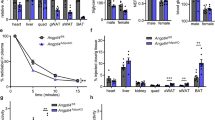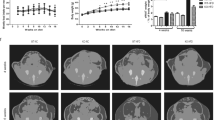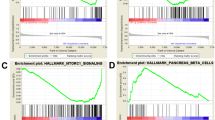Abstract
Objective:
Apolipoprotein E (apoE), a key protein in lipid metabolism, is highly expressed in adipose tissues. Studies have shown that human APOE*4 is associated with a lower body mass index but with a greater risk of coronary heart disease compared with other APOE alleles. To define the isoform-specific role of apoE in regulating the expandability and functionality of adipose tissues, we investigated the effects of diet-induced obesity in mice whose endogenous Apoe gene has been replaced by either the human APOE*3 or APOE*4 allele.
Results:
After 8 weeks on a Western-type high-fat diet, male APOE4 mice displayed impaired tolerance to glucose and fat overload compared with APOE3 mice. Subcutaneous fat tissues in APOE4 and APOE3 mice after high fat feeding were not different. In contrast, although epididymal fat tissues in APOE4 mice gained 30% less weight during the high fat feeding than in APOE3 mice, they showed impaired insulin-stimulated glucose uptake ex vivo. Epididymal APOE4 adipocytes were larger in size than APOE3 adipocytes, and expressed reduced levels of mRNA for peroxisome proliferator-activated receptor γ2 and adiponectin, important markers of adipocyte functionality. Adenoviral expression of apoE3 in apoE-null culture adipocytes induced adiponectin mRNA in a dose-dependent manner, but the induction was significantly blunted in cells overexpressing apoE4. However, in contrast to the apoE3-expressing cells, Glut1, but not Glut4, expression levels were positively correlated with increased apoE4 mRNA, suggesting that apoE4 expression in adipocyte interferes in insulin-sensing pathways.
Conclusion:
Dysfunctional epididymal adipose tissues contribute to the accelerated impairment of glucose tolerance in APOE4 mice fed a Western-type diet. Our results underscore the importance of functionality of individual fat depots rather than total fat mass as a determinant for metabolic disturbance during diet-induced obesity.
This is a preview of subscription content, access via your institution
Access options
Subscribe to this journal
Receive 12 print issues and online access
$259.00 per year
only $21.58 per issue
Buy this article
- Purchase on Springer Link
- Instant access to full article PDF
Prices may be subject to local taxes which are calculated during checkout








Similar content being viewed by others
References
Garg A . Lipodystrophies. Am J Med 2000; 108: 143–152.
Haslam DW, James WP . Obesity. Lancet 2005; 366: 1197–1209.
Wellen KE, Hotamisligil GS . Inflammation, stress, and diabetes. J Clin Invest 2005; 115: 1111–1119.
Zechner R, Moser R, Newman T, Fried S, Breslow J . Apolipoprotein E gene expression in mouse 3T3-L1 adipocytes and human adipose tissue and its regulation by differentiation and lipid content. J Biol Chem 1991; 266: 10583–10588.
Elosua R, Demissie S, Cupples LA, Meigs JB, Wilson PWF, Schaefer EJ et al. Obesity modulates the association among APOE genotype, insulin, and glucose in men. Obesity Res 2003; 11: 1502–1508.
Volcik KA, Barkley RA, Hutchinson RG, Mosley TH, Heiss G, Sharrett AR et al. Apolipoprotein E polymorphisms predict low density lipoprotein cholesterol levels and carotid artery wall thickness but not incident coronary heart disease in 12 491 ARIC study participants. Am J Epidemiol 2006; 164: 342–348.
Feitosa MF, Rice T, North KE, Kraja A, Rankinen T, Leon AS et al. Pleiotropic QTL on chromosome 19q13 for triglycerides and adiposity: the HERITAGE Family Study. Atherosclerosis 2006; 185: 426–432.
Knouff C, Hinsdale ME, Mezdour H, Altenburg MK, Watanabe M, Quarfordt SH et al. Apo E structure determines VLDL clearance and atherosclerosis risk in mice. J Clin Invest 1999; 103: 1579–1586.
Davignon J, Gregg R, Sing C . Apolipoprotein E polymorphism and atherosclerosis. Arterioscler Thromb Vasc Biol 1988; 8: 1–21.
Wilson PWF, Schaefer EJ, Larson MG, Ordovas JM . Apolipoprotein E alleles and risk of coronary disease: a meta-analysis. Arterioscler Thromb Vasc Biol 1996; 16: 1250–1255.
Bennet AM, Di Angelantonio E, Ye Z, Wensley F, Dahlin A, Ahlbom A et al. Association of apolipoprotein E genotypes with lipid levels and coronary risk. JAMA 2007; 298: 1300–1311.
Shriver M, Boerwinkle E, Hewett-Emmett D, Hanis C . Frequency and effects of apolipoprotein E polymorphism in Mexican-American NIDDM subjects. Diabetes 1991; 40: 334–337.
Meigs J, Ordovas J, Cupples L, Singer D, Nathan D, Schaefer E et al. Apolipoprotein E isoform polymorphisms are not associated with insulin resistance: the Framingham Offspring Study. Diabetes Care 2000; 23: 669–674.
Scuteri A, Najjar SS, Muller D, Andres R, Morrell CH, Zonderman AB et al. apoE4 allele and the natural history of cardiovascular risk factors. Am J Physiol Endocrinol Metab 2005; 289: E322–E327.
Sullivan PM, Mezdour H, Aratani Y, Knouff C, Najib J, Reddick RL et al. Targeted replacement of the mouse apolipoprotein E gene with the common human APOE3 allele enhances diet-induced hypercholesterolemia and atherosclerosis. J Biol Chem 1997; 272: 17972–17980.
Arbones-Mainar JM, Navarro MA, Acin S, Guzman MA, Arnal C, Surra JC et al. Trans-10, cis-12- and cis-9, trans-11-conjugated linoleic acid isomers selectively modify HDL-apolipoprotein composition in apolipoprotein E knockout mice. J Nutr 2006; 136: 353–359.
Dekroon RM, Armati PJ . Endocytosis of apoE-EGFP by primary human brain cultures. Cell Biol Int 2002; 26: 761–770.
Altenburg M, Arbones-Mainar J, Johnson L, Wilder J, Maeda N . Human LDL receptor enhances sequestration of ApoE4 and VLDL remnants on the surface of hepatocytes but not their internalization in mice. Arterioscler Thromb Vasc Biol 2008; 28: 1104–1110.
Conner DA . Mouse embryo fibroblast (MEF) feeder cell preparation. Curr Protoc Mol Biol 2001; Chapter 23: Unit 23.2.
Bickerton AST, Roberts R, Fielding BA, Hodson L, Blaak EE, Wagenmakers AJM et al. Preferential uptake of dietary fatty acids in adipose tissue and muscle in the postprandial period. Diabetes 2007; 56: 168–176.
Unger RH . Minireview: weapons of lean body mass destruction: the role of ectopic lipids in the metabolic syndrome. Endocrinology 2003; 144: 5159–5165.
Sniderman AD . Postprandial hypertriglyceridemia(s): time to enlarge our pathophysiologic perspective. Eur J Clin Invest 2000; 30: 935–937.
Medina-Gomez G, Gray SL, Yetukuri L, Shimomura K, Virtue S, Campbell M et al. PPAR gamma 2 prevents lipotoxicity by controlling adipose tissue expandability and peripheral lipid metabolism. PLoS Genet 2007; 3: e64.
Hu E, Liang P, Spiegelman BM . AdipoQ is a novel adipose-specific gene dysregulated in obesity. J Biol Chem 1996; 271: 10697–10703.
Kim J-Y, van de Wall E, Laplante M, Azzara A, Trujillo ME, Hofmann SM et al. Obesity-associated improvements in metabolic profile through expansion of adipose tissue. J Clin Invest 2007; 117: 2621–2637.
Weisberg SP, McCann D, Desai M, Rosenbaum M, Leibel RL, Ferrante Jr AW . Obesity is associated with macrophage accumulation in adipose tissue. J Clin Invest 2003; 112: 1796–1808.
Chiba T, Nakazawa T, Yui K, Kaneko E, Shimokado K . VLDL induces adipocyte differentiation in ApoE-dependent manner. Arterioscler Thromb Vasc Biol 2003; 23: 1423–1429.
Huang ZH, Reardon CA, Mazzone T . Endogenous ApoE expression modulates adipocyte triglyceride content and turnover. Diabetes 2006; 55: 3394–3402.
Gao J, Katagiri H, Ishigaki Y, Yamada T, Ogihara T, Imai J et al. Involvement of apolipoprotein E in excess fat accumulation and insulin resistance. Diabetes 2007; 56: 24–33.
Hofmann SM, Perez-Tilve D, Greer TM, Coburn BA, Grant E, Basford JE et al. Defective lipid delivery modulates glucose tolerance and metabolic response to diet in apolipoprotein E deficient mice. Diabetes 2008; 57: 5–12.
Weisgraber K, Mahley R . Human apolipoprotein E: the Alzheimer's disease connection. FASEB J 1996; 10: 1485–1494.
Sima A, Iordan A, Stancu C . Apolipoprotein E polymorphism—a risk factor for metabolic syndrome. Clin Chem Lab Med 2007; 45: 1149–1153.
Michikawa M, Fan Q-W, Isobe I, Yanagisawa K . Apolipoprotein E exhibits isoform-specific promotion of lipid efflux from astrocytes and neurons in culture. J Neurochem 2000; 74: 1008–1016.
Lucic D, Huang ZH, Gu DS, Altenburg MK, Maeda N, Mazzone T . Regulation of macrophage apoE secretion and sterol efflux by the LDL receptor. J Lipid Res 2007; 48: 366–372.
Miyata M, Smith JD . Apolipoprotein E allele-specific antioxidant activity and effects on cytotoxicity by oxidative insults and beta-amyloid peptides. Nat Genet 1996; 14: 55–61.
Altenburg M, Johnson L, Wilder J, Maeda N . Apolipoprotein E4 in macrophages enhances atherogenesis in a low density lipoprotein receptor-dependent manner. J Biol Chem 2007; 282: 7817–7824.
Cohen AW, Hnasko R, Schubert W, Lisanti MP . Role of caveolae and caveolins in health and disease. Physiol Rev 2004; 84: 1341–1379.
Cohen AW, Razani B, Schubert W, Williams TM, Wang XB, Iyengar P et al. Role of caveolin-1 in the modulation of lipolysis and lipid droplet formation. Diabetes 2004; 53: 1261–1270.
Kim S, Huang L-W, Snow KJ, Ablamunits V, Hasham MG, Young TH et al. A mouse model of conditional lipodystrophy. Proc Natl Acad Sci USA 2007; 104: 16627–16632.
LaRosa PC, Miner J, Xia Y, Zhou Y, Kachman S, Fromm ME . Trans-10, cis-12 conjugated linoleic acid causes inflammation and delipidation of white adipose tissue in mice: a microarray and histological analysis. Physiol Genomics 2006; 27: 282–294.
Nadler ST, Stoehr JP, Schueler KL, Tanimoto G, Yandell BS, Attie AD . The expression of adipogenic genes is decreased in obesity and diabetes mellitus. Proc Natl Acad Sci USA 2000; 97: 11371–11376.
Garvey WT, Maianu L, Huecksteadt TP, Birnbaum MJ, Molina JM, Ciaraldi TP . Pretranslational suppression of a glucose transporter protein causes insulin resistance in adipocytes from patients with non-insulin-dependent diabetes mellitus and obesity. J Clin Invest 1991; 87: 1072–1081.
Bloch-Damti A, Bashan N . Proposed mechanisms for the induction of insulin resistance by oxidative stress. Antioxid Redox Signal 2005; 7: 1553–1567.
Carr DB, Utzschneider KM, Hull RL, Kodama K, Retzlaff BM, Brunzell JD et al. Intra-abdominal fat is a major determinant of the national cholesterol education program adult treatment panel III criteria for the metabolic syndrome. Diabetes 2004; 53: 2087–2094.
Abate N, Garg A, Peshock RM, Stray-Gundersen J, Grundy SM . Relationships of generalized and regional adiposity to insulin sensitivity in men. J Clin Invest 1995; 96: 88–98.
Vega GL, Adams-Huet B, Peshock R, Willett D, Shah B, Grundy SM . Influence of body fat content and distribution on variation in metabolic risk. J Clin Endocrinol Metab 2006; 91: 4459–4466.
Tansey JT, Sztalryd C, Gruia-Gray J, Roush DL, Zee JV, Gavrilova O et al. Perilipin ablation results in a lean mouse with aberrant adipocyte lipolysis, enhanced leptin production, and resistance to diet-induced obesity. Proc Natl Acad Sci USA 2001; 98: 6494–6499.
Fonseca V . Effect of thiazolidinediones on body weight in patients with diabetes mellitus. Am J Med 2003; 115 (Suppl. 8A): 42S–48S.
Konrad D, Rudich A, Schoenle E . Improved glucose tolerance in mice receiving intraperitoneal transplantation of normal fat tissue. Diabetologia 2007; 50: 833–839.
Laclaustra M, Corella D, Ordovas JM . Metabolic syndrome pathophysiology: the role of adipose tissue. Nutr Metab Cardiovasc Dis 2007; 17: 125–139.
Acknowledgements
We thank Drs Theodore Mazzone and Jesus Osada for their helpful comments. Dr Kumar Pandya, Avani Pendse and Anna Garcia for their critical reading of our paper. This study was supported by NIH grants; HL42630 and HL87946. JMA-M was partially supported by a Medicina Regenerativa fellowship from the Instituto Aragones de Ciencias de la Salud.
Author information
Authors and Affiliations
Corresponding author
Rights and permissions
About this article
Cite this article
Arbones-Mainar, J., Johnson, L., Altenburg, M. et al. Differential modulation of diet-induced obesity and adipocyte functionality by human apolipoprotein E3 and E4 in mice. Int J Obes 32, 1595–1605 (2008). https://doi.org/10.1038/ijo.2008.143
Received:
Revised:
Accepted:
Published:
Issue Date:
DOI: https://doi.org/10.1038/ijo.2008.143
Keywords
This article is cited by
-
Obesity affects brain cortex gene expression in an APOE genotype and sex dependent manner
International Journal of Obesity (2024)
-
Association of the APOE gene variants with depression in type 2 diabetes
Journal of Diabetes & Metabolic Disorders (2023)
-
APOΕ4 lowers energy expenditure in females and impairs glucose oxidation by increasing flux through aerobic glycolysis
Molecular Neurodegeneration (2021)
-
Is Fat Mass Cross-Sectionally Associated with Cortical Aβ Load in the Human Brain?
The Journal of nutrition, health and aging (2019)
-
New mechanistic insights on the metabolic-disruptor role of chlorpyrifos in apoE mice: a focus on insulin- and leptin-signalling pathways
Archives of Toxicology (2018)



